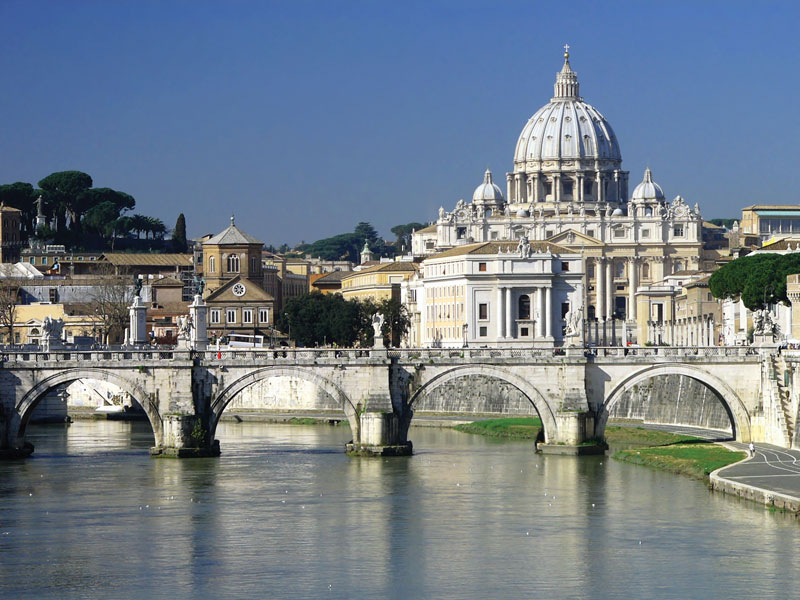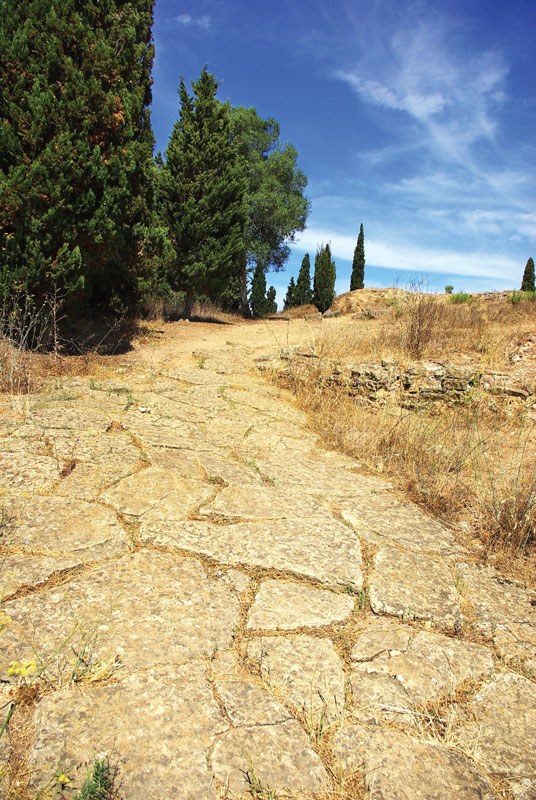
Aqueduct - A manmade channel used for delivering water to Roman towns. Public fountains and baths made water available to everyone. Wealthy Romans had running water in their homes.
Province - An area of the Roman empire that was outside Italy.
Nelson, Ken. (2016). Ancient Rome for Kids: Glossary and Terms. Ducksters.
The development of civilisation is affected by geography. Rome did not spring into being as a power on the Italian peninsula. It began as a tiny village along the Tiber River. It was an excellent location. The soil was good so crops could be grown easily. It was surrounded by 7 hills, offering a natural defensive barrier. It was on a river, the Tiber River, giving these early settlers access to fresh water for drinking and bathing, as well as a waterway for trade. With all these advantages, it's no surprise that Rome grew quickly.
http://rome.mrdonn.org/geography.html
 Ancient Rome was built on the swiftly flowing Tiber River. The Romans called it Father Tiber. They loved this stream that watered their land, joined the city with the sea, and helped to protect them from invasion. Yet sometimes disastrous floods rushed over the river’s banks. Even today the Tiber sometimes overflows, though great flood-control embankments have lessened the danger.
Ancient Rome was built on the swiftly flowing Tiber River. The Romans called it Father Tiber. They loved this stream that watered their land, joined the city with the sea, and helped to protect them from invasion. Yet sometimes disastrous floods rushed over the river’s banks. Even today the Tiber sometimes overflows, though great flood-control embankments have lessened the danger.
Tiber River. (2016). In Encylopaedia Britannica.
Tiber River. [Image]. In Encyclopædia Britannica.
 The elaborate system that served the capital of the Roman Empire, remains a major engineering achievement. Over a period of 500 years—from 312 bce to 226 ce—11 aqueducts were built to bring water to Rome from as far away as 92 km. Some of those aqueducts are still in use. Only a portion of Rome’s aqueduct system actually crossed over valleys on stone arches (50 km out of a total of about 420 km); the rest consisted of underground conduits made mostly of stone and terra-cotta pipe but also of wood, leather, lead, and bronze. Water flowed to the city by the force of gravity alone and usually went through a series of distribution tanks within the city. Rome’s famous fountains and baths were supplied in that way. Generally, water was not stored, and the excess was used to flush out sewers to aid the city’s sanitation.
The elaborate system that served the capital of the Roman Empire, remains a major engineering achievement. Over a period of 500 years—from 312 bce to 226 ce—11 aqueducts were built to bring water to Rome from as far away as 92 km. Some of those aqueducts are still in use. Only a portion of Rome’s aqueduct system actually crossed over valleys on stone arches (50 km out of a total of about 420 km); the rest consisted of underground conduits made mostly of stone and terra-cotta pipe but also of wood, leather, lead, and bronze. Water flowed to the city by the force of gravity alone and usually went through a series of distribution tanks within the city. Rome’s famous fountains and baths were supplied in that way. Generally, water was not stored, and the excess was used to flush out sewers to aid the city’s sanitation.
Aqueduct. (2016). In Encyclopædia Britannica.
Nimes: Pont du Gard. [Image]. In Encyclopædia Britannica.

Rome, ancient: location. [Image]. In Encyclopædia Britannica.
 The Roman road system was an outstanding transportation network of the ancient Mediterranean world, extending from Britain to the Tigris-Euphrates river system and from the Danube River to Spain and northern Africa. In all, the Romans built 80,000 km of hard-surfaced highway, primarily for military reasons.
The Roman road system was an outstanding transportation network of the ancient Mediterranean world, extending from Britain to the Tigris-Euphrates river system and from the Danube River to Spain and northern Africa. In all, the Romans built 80,000 km of hard-surfaced highway, primarily for military reasons.
The Roman roads were notable for their straightness, solid foundations, cambered surfaces facilitating drainage, and use of concrete made from pozzolana (volcanic ash) and lime.
Roman road system. (2016). In Encyclopædia Britannica.
Rome, ancient: ancient Roman road. [Image]. In Encyclopædia Britannica.
 The Roman Forum was the most important forum in ancient Rome, situated on low ground between the Palatine and Capitoline hills. The Roman Forum was the scene of public meetings, lawcourts, and gladiatorial combats in republican times and was lined with shops and open-air markets. Under the empire, when it primarily became a centre for religious and secular spectacles and ceremonies, it was the site of many of the city’s most imposing temples and monuments.
The Roman Forum was the most important forum in ancient Rome, situated on low ground between the Palatine and Capitoline hills. The Roman Forum was the scene of public meetings, lawcourts, and gladiatorial combats in republican times and was lined with shops and open-air markets. Under the empire, when it primarily became a centre for religious and secular spectacles and ceremonies, it was the site of many of the city’s most imposing temples and monuments.
Roman Forum. (2016). In Encyclopædia Britannica.
Roman Forum: Temple of Saturn . [Image]. In Encyclopædia Britannica.

"Reconstruction of Reaping Machine Used in Gaul in Ancient Roman Times." Research in Context. Farmington Hills, MI: Gale, 1890. Research in Context. Web. 17 Mar. 2016.
About 90 percent of the ancient Romans relied on farm work to make a living. As the Roman Empire became more powerful and demand for Roman goods grew, crop output increased. More labour was needed to work the fields. This meant relying on slave labour. Roman farming consisted of two operations: small, self-sufficient farms and large-scale, highly profitable farms. Farming techniques grew to include complex systems and tools to improve crop yields.
Ancient Rome: Farming. (2015). In Research in Context. Farmington Hills, MI: Gale.